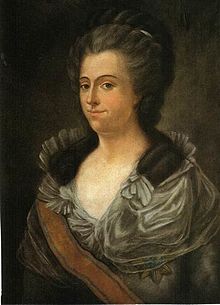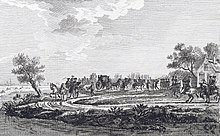Wilhelmine of Prussia (1751-1820)

Friederike Sophie Wilhelmine of Prussia (born August 7, 1751 in Berlin , † June 9, 1820 in Het Loo Castle , Apeldoorn ) was a Prussian princess and inheritance holder of the Netherlands by marriage .
Life
Wilhelmine was the only daughter of Prince August Wilhelm of Prussia (1722–1758) from his marriage to Luise Amalie (1722–1780), daughter of Duke Ferdinand Albrecht II of Braunschweig-Wolfenbüttel and thus a sister of the Prussian King Friedrich Wilhelm II.
Wilhelmine married Prince Wilhelm V of Orange , governor of the Netherlands (1748–1806) in Berlin on October 4, 1767 . The marriage was negotiated at the instigation of her uncle, Friedrich II. , Through Friedrich Wilhelm von Thulemeyer , who had been the Prussian envoy in the Netherlands since 1763 . With her uncle Frederick the Great, whom she was considered to be his favorite niece, she had a long and detailed correspondence with political content. Based on his advice, she tried to gain political influence in the Netherlands.
Wilhelm V of Orange increasingly came into political conflict with the local patriot movement in the 1780s . These democratic forces grew stronger after the disastrous end of the Fourth Anglo-Dutch War (1780–1784) and Wilhelm was deposed as captain general of the province of Holland.
Wilhelmine's attempts to persuade her uncle Friedrich and his successor Friedrich Wilhelm II to intervene militarily in their favor initially failed. At the end of June 1787, she embarked on a provocative journey from Nijmegen , the seat of the Orange Court, to The Hague , her former residence in Holland, in order to gather supporters there. Her path was blocked near Gouda - the Goejanverwellesluis , which has become historic as a result . When she returned, she described her rejection untruthfully as a dishonorable captivity, which enabled her to get her brother to march into Holland with Prussian troops under Karl Wilhelm Ferdinand von Braunschweig in September 1787 , who restored the power of the Orange governorship.
Wilhelmine appointed the capable Laurens Pieter van de Spiegel as a pensioner and continued to exert political influence, talking about the “party of the princess”. The governor couple were expelled by the French in 1795 and fled to England. Wilhelm V died in exile. Wilhelmine returned to the Netherlands in 1813 and saw her son being proclaimed King of the Netherlands in 1815.
progeny
Wilhelmine had the following children from their marriage:
- Son (* / † 1769)
- Friederike Luise Wilhelmine (1770–1819)
- ⚭ 1790 Hereditary Prince Karl Georg August of Braunschweig-Wolfenbüttel (1766–1806)
- Wilhelm I (1772–1843), King of the Netherlands
- ⚭ 1. 1791 Princess Friederike Luise Wilhelmine of Prussia (1774–1837)
- ⚭ 2. 1841 Countess Henriëtte d'Oultremont de Wégimont (1792–1864)
- Friedrich (1774–1799)
literature
- Meindest Evers: Encounters with German culture. Dutch-German relations between 1780 and 1920. Königshausen & Neumann, Würzburg 2006, ISBN 3-8260-3260-8 , p. 33 f.
- Ms. Förster : Prussia's heroes in war and peace. A history of Prussia from the great elector to the end of the wars of freedom. Department 2: Modern and Recent Prussian History. (Since the death of Friedrich II up to our day). Volume 1 (Volume 3 of the complete works). Gustav Hempel, Berlin 1851, p. 118 ff.
- PL Müller : Wilhelmine . In: Allgemeine Deutsche Biographie (ADB). Volume 43, Duncker & Humblot, Leipzig 1898, pp. 232-234.
Web links
Individual evidence
- ^ Brigitte Meier : Friedrich Wilhelm II. King of Prussia (1744-1797). A life between rococo and revolution . Pustet, Regensburg 2007, ISBN 978-3-7917-2083-8 , p. 113 f., There also the following
| personal data | |
|---|---|
| SURNAME | Prussia, Wilhelmine von |
| ALTERNATIVE NAMES | Prussia, Friederike Sophie Wilhelmine von (full name) |
| BRIEF DESCRIPTION | Prussian princess and inheritance holder of the Netherlands by marriage |
| DATE OF BIRTH | August 7, 1751 |
| PLACE OF BIRTH | Berlin |
| DATE OF DEATH | June 9, 1820 |
| Place of death | Het Loo Castle , Apeldoorn |

